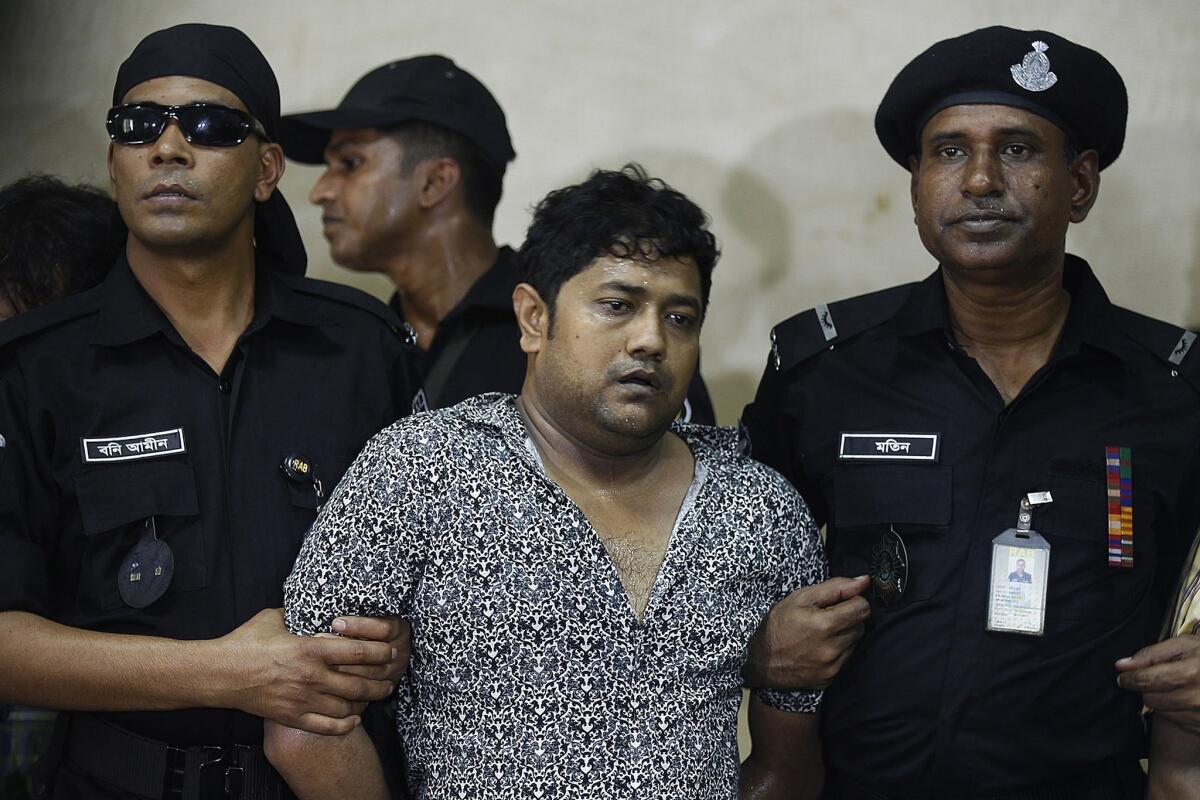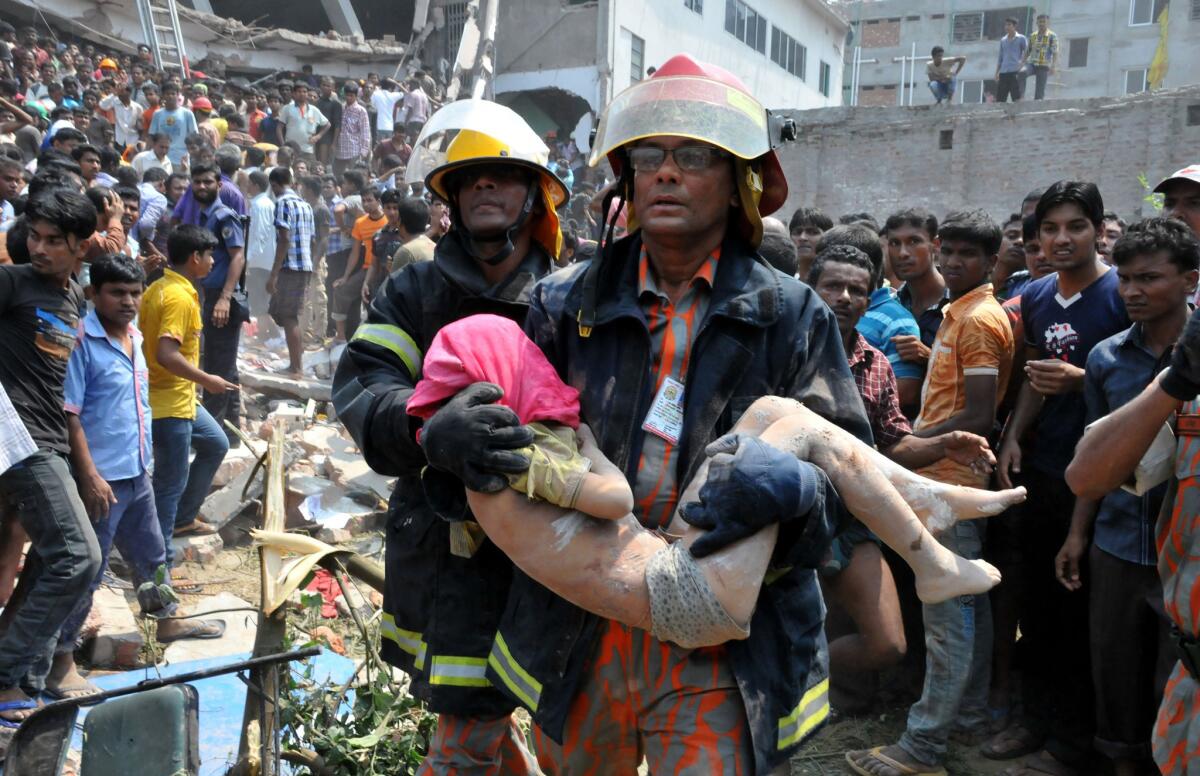Story So Far: A quick guide to Bangladesh’s Rana Plaza collapse and its lasting impact

Bangladesh property owner Sohel Rana was charged with murder in the 2013 collapse of Rana Plaza.
- Share via
The collapse of Rana Plaza in Bangladesh, considered the deadliest disaster in the history of the garment industry, killed more than 1,100 people in 2013. In its wake, international outcry highlighted some of the abysmal conditions factory workers were subjected to in the Asian country. Recently murder charges were filed in Bangladesh against people accused of ignoring building code violations before the collapse.
Here’s some background on the fatal incident.
Rana Plaza, where clothes were made
The building in the outskirts of Bangladesh's capital, Dhaka, stood eight stories tall and contained clothing factories, apartments and several small shops frequented by locals. The clothing manufactured in Rana Plaza — also known as the Sacar building — was for brands such as the Canada-based Joe Fresh and U.S. retailer JCPenney. Thousands of workers were packed into several floors in the building daily to churn out garments.
Bangladesh has a $20-billion textile export industry — the world’s second-largest, after China — powered by extremely cheap labor costs. It’s a major supplier of clothing to U.S. and European apparel companies.
“The global textile and clothing industry is very footloose," Rajiv Biswas, Asia-Pacific chief economist with the financial information firm IHS Global Insight, told the Los Angeles Times in 2013. "So low-cost textile manufacturers face considerable pressures to keep costs low and maintain global competitiveness."
Before collapse, cracks were showing
On the morning of April 24, 2013, the concrete building caved in, killing more than 1,100 people and injuring more than 2,000 others. It took several weeks for searchers to recover all the bodies.
Several days before the collapse, concerns were raised about visible cracks in the building. Some workers said they were told to enter the building despite their worries.

A rescuer carries an injured boy from the rubble of Rana Plaza on April 24, 2015 in Dhaka, Bangladesh. The eight-story commercial building collapsed, killing over a thousand people and thousands more injured. Authorities in Balgladesh charged 42 people with murder on Monday in the collapse, including the building’s owner. (Shariful Islam/Xinhua/Zuma Press/TNS)
A rescuer carries an injured boy from the rubble of Rana Plaza in April 2013. (Shariful Islam / Xinhua/Zuma Press/TNS)
Charges filed
On June 1, 2015, murder charges were filed against 42 people — including the building’s owner, Sohel Rana, as well as owners of factories inside the building and at least a dozen government officials. Rana tried to flee the country after the building collapsed, but he was captured by authorities and held until he was charged.
Nearly 20 of the accused faced additional charges associated with violating building codes as three extra floors had been added to what was only supposed to be a five-story building. In an announcement, authorities said factory officials ignored warnings and let workers enter the building despite those visible cracks. Moreover, authorities charged the government officials whose jobs involved overseeing the structure's safety.
The accused were initially expected to face charges of culpable homicide, but authorities ultimately elevated the charges, citing the magnitude of the disaster. According to the Associated Press, lead investigator Bijoy Krishna Kar of the country’s Criminal Investigation Department said a court hearing for all of the accused is set for June 28.
Fallout from the collapse
The collapse of Rana Plaza spotlighted abysmal conditions faced by factory workers and spurred some change. Before the building collapse, minimum wage for Bangladesh's nearly 4 million factory workers, most of them women, was about $37 a month. It has since been raised to $68, which is still one of the lowest minimum wages in the world. In addition, the country has sought to impose tougher regulations in an effort to root out corruption in the construction industry.
The Bangladesh Accord for Fire and Building Safety, an independent legally binding agreement between brands and trade unions, was created in the years since the collapse. Under the agreement, signed by companies including H&M, Benetton and American Eagle Outfitters, the brands must undertake inspections of garment factories around the world and of worker training.
Still, troubles persist.
Researchers estimate the total number of factories in Bangladesh is around 7,000, with many that lie outside the reach of the country’s own inspection regulators, though employ nearly half of the garments industry workforce.
Compensation to victims
In the aftermath of the collapse, some companies provided donations to aid the thousands of affected families. Several companies, such as Wal-Mart, Gap and Children's Place donated. The Arkansas-based Wal-Mart — which in the past had used factories in Rana Plaza — donated indirectly to the victims by giving $3 million to BRAC USA, the North American affiliate of the Bangladeshi development organization that helped supply aid to victims and families. Gap, which was not directly linked to Rana Plaza, supplied half a million dollars to BRAC USA.
“Rana Plaza underscores the need for government, factory owners, development organizations, labor groups and retailers to take action to improve the lives of garment workers,” Gap spokesman Bill Chandler said last year.
UPDATES
June 2, 10:41 a.m.: This story has been updated with additional information.
Times staff writer Shashank Bengali contributed to this report.
Follow @kurtisalee and email [email protected]
MORE ON THE COLLAPSE: 42 face murder charges in deadly collapse of Bangladesh garment factory
Sign up for Essential California
The most important California stories and recommendations in your inbox every morning.
You may occasionally receive promotional content from the Los Angeles Times.








